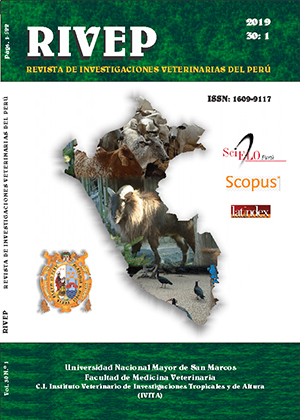Anatomical and histological study of the arteries that irrigate the pancreas and small intestine of the alpaca (Vicugna pacos)
DOI:
https://doi.org/10.15381/rivep.v30i1.15697Keywords:
alpaca; anatomy; artery; histology; jejunum; pancreasAbstract
This study describes the arteries that irrigate the pancreas and small intestine of the alpaca by dissection, angiography, vascular repletion and histology. Six alpacas were used, of which four were older than two years and two were four months old. Macroscopically, the pancreas was mainly irrigated by the pancreatic duodenal cranial and caudal arteries; in addition, branches from the hepatic artery, splenic artery and the branch of the first jejunal artery. These arteries and branches entered the pancreas (left, right and body portions) forming anastomosis in the form of nets, inside the parenchyma. Histological techniques showed that alpaca arteries have two layers, compact and spongy, forming the adventitia tunic of the duodenal cranial and caudal pancreatic arteries, celiac and cranial mesenteric arteries. The caudal duodenal pancreatic artery had the thickest compact adventitial layer, this artery supplying the right pancreatic lobe, part of the left lobe and the duodenum.
Downloads
Downloads
Published
Issue
Section
License
Copyright (c) 2019 Rose Barreto R., Alberto Sato S., Marcelo Daniel Ghezzi, Francisco Santos R., Alexander Chávez R., Miluska Navarrete Z.

This work is licensed under a Creative Commons Attribution-NonCommercial-ShareAlike 4.0 International License.
AUTHORS RETAIN THEIR RIGHTS:
a. Authors retain their trade mark rights and patent, and also on any process or procedure described in the article.
b. Authors retain their right to share, copy, distribute, perform and publicly communicate their article (eg, to place their article in an institutional repository or publish it in a book), with an acknowledgment of its initial publication in the Revista de Investigaciones Veterinarias del Perú (RIVEP).
c. Authors retain theirs right to make a subsequent publication of their work, to use the article or any part thereof (eg a compilation of his papers, lecture notes, thesis, or a book), always indicating the source of publication (the originator of the work, journal, volume, number and date).



